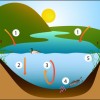Abstract
Florida’s thousands of lakes are shallower than most people realize, and some unique properties of shallow lakes make them challenging to restore if they have been degraded by nutrients or other pollutants. This 4-page fact sheet examines how water managers track nutrients as they cycle through Florida’s lakes. Written by Karl Havens, and published by the UF Department of Sea Grant, January 2013.
References
Conley, D.J., H.W. Paerl, R.W. Howarth, D.F. Boesch, S.P. Seitzinger, K.E. Havens, C. Lancelot, and G.E. Likens. 2009. Controlling eutrophication: nitrogen and phosphorus. Science 323: 1014-1015. https://doi.org/10.1126/science.1167755
Havens, K.E., J.R. Beaver, D.A. Casamatta, T.L. East, R.T. James, P. McCormick, E.J. Phlips and A.J. Rodusky. 2011. Hurricane effects on the planktonic food web of a large subtropical lake. Journal of Plankton Research 33: 1081-1094. https://doi.org/10.1093/plankt/fbr002
Havens, K.E. and C.L. Schelske. 2001. The importance of considering biological processes when setting total maximum daily loads (TMDL) for phosphorus in shallow lakes and reservoirs. Environmental Pollution 113: 1-9. https://doi.org/10.1016/S0269-7491(00)00235-9
James, C., J. Fisher, V. Russel, S. Collings and B. Moss. 2005. Nitrate availability and hydrophyte species richness in shallow lakes. Freshwater Biology 50: 1059-1063. https://doi.org/10.1111/j.1365-2427.2005.01375.x
Lewis, W.M., Jr., W.A. Wurtsbaugh and H.W. Paerl. 2011. Rationale for control of anthropogenic nitrogen and phosphorus to reduce eutrophication of inland waters. Environmental Science and Technology 45: 300-305. https://doi.org/10.1021/es202401p
Scheffer M., S.H. Hosper, M.L. Meijer, B. Moss and E. Jeppesen. 1993. Alternative equilibria in shallow lakes. Trends in Evolution and Ecology 8: 275-279. https://doi.org/10.1016/0169-5347(93)90254-M
Unless otherwise specified, articles published in the EDIS journal after January 1, 2024 are licensed under a Creative Commons Attribution-NonCommercial-NoDerivs 4.0 International (CC BY-NC-ND 4.0) license.

